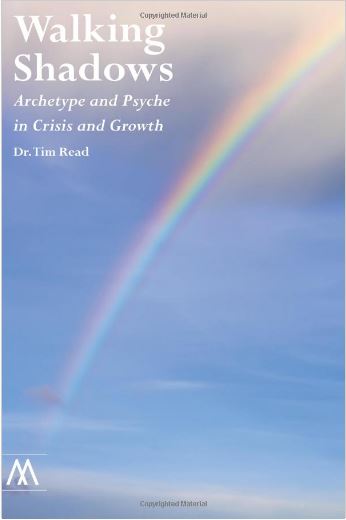 Walking Shadows: Archetype and Psyche in Crisis and Growth by Dr. Tim Read
Walking Shadows: Archetype and Psyche in Crisis and Growth by Dr. Tim Read
Reviewed by David Lorimer
In this bold book, Tim Read skilfully navigates the SMN guidelines of intuitive insight and rational analysis by combining his own psycho-spiritual journey with his extensive psychiatric experience of spiritual emergence and emergency, especially in relation to both positive and negative numinous experiences. The three parts explore intense states of meaning, self, shadow and us, and working with the numinous. He begins by giving two contrasting case histories before providing some theoretical background with Plato’s Cave and Jung’s archetypal voyage into the unconscious. This scheme already puts him beyond the narrow focus of the prevailing neural model and within a context of meaning. He further explores archetypal crises and presents what he calls a biopsychosocial archetypal model (BPSA) to make sense of his own experiences as well as those of his patients. He coins the term high or low archetypal penetrance to characterise different psychic contents. This leads on to a discussion of synchronicity and a meaning field drawing on the work of David Bohm, with his implicate and explicate orders. His model provides a much richer framework of interpretation.
As the Chinese point out, crisis is both a danger and an opportunity, as Tim experienced personally and in his work at the Crisis Intervention Service where patients need real understanding from the physicians, not simply a neurochemical intervention. The breakdown can potentially lead to a breakthrough, and again Tim steps outside orthodoxy by discussing the impact of kundalini experience while respecting cases where more orthodox approaches may be helpful. He observes that genetic inheritance predisposing to mood disorders might also predispose to a raising of archetypal penetrance. We are all on a transformative journey, whether we understand this in terms of the Grail, the Self or the Hero’s Journey – and correspondingly open to pitfalls and periods of darkness within. This also involves facing the shadow, integrating masculine and feminine and negotiating ego death and midlife crisis. Here he brings in the work of Stan Grof, with whom he has done extensive training both with his perinatal and holotropic breathing work. He puts this work on a par with Jung. At the other end of the scale, he encourages physicians not to neglect basic attitudes like kindness.
The third part begins with a chapter on death, including remembrance of previous lives and archetypal dimensions. It is very moving to read about the death of his sister Philippa and her beautiful story about a crystal bowl as a symbol of her life. The gems of her soul experience eventually fill this crystal bowl in spite of her suffering. Tim then moves on to mindfulness and relates his experience at a darkness retreat involving four days and three nights of wearing a thick blindfold. This was a revealing and transformative experience, the kind that needs extensive integration. He also worked with Roger Woolger where he had a vivid past life memory that he did not interpret literally, but rather as a resonance of meaning that could perhaps be taken further by Jungian active imagination, alongside which he includes shamanism and the work of Robert Monroe. In all this work, it is important not to confuse levels and understand the symbolism. He applies his principles of mindset, setting and integration to his discussion of psychedelics as a gateway to the numinous and increasing archetypal penetrance. Integration, he believes, is always critical otherwise one is like the subject of the TS Eliot poem who had the experience but missed the meaning. Tim finishes with a chapter on holotropic breathwork and gives the last word to Rumi about the importance of fulfilling one’s existential task. This is certainly important but I missed a concluding chapter bringing all Tim’s insights together. However, he has written an important book that should inform the work of all mental health professionals.
